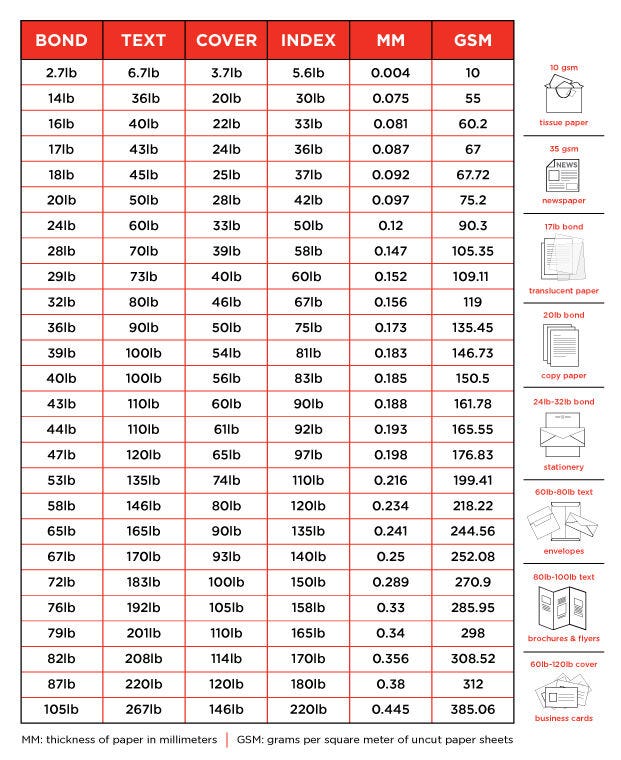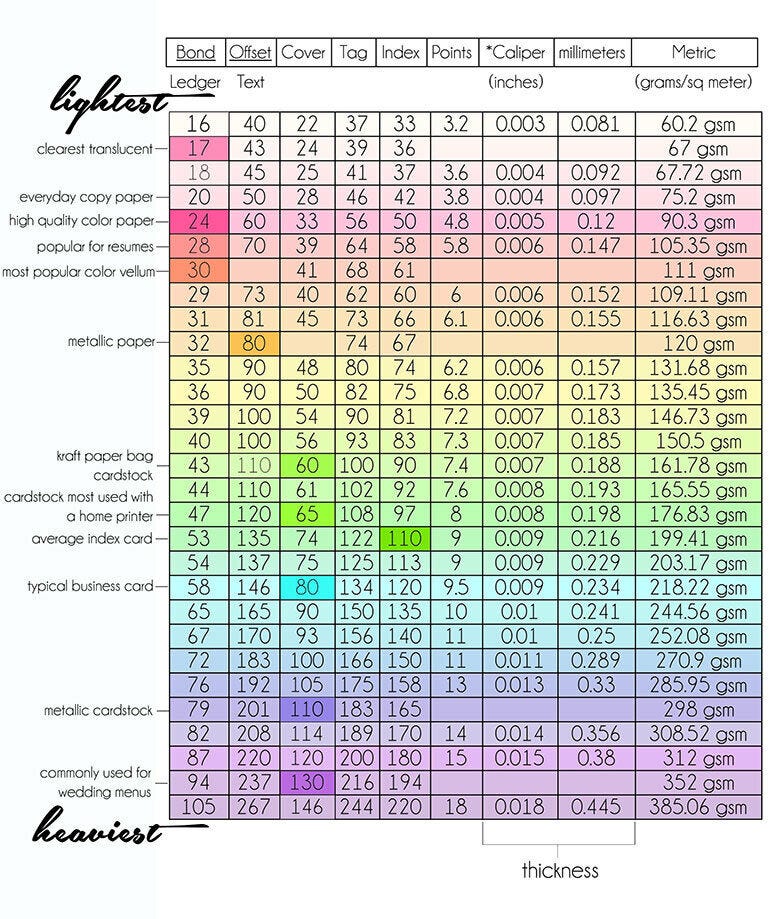Paper Weight Chart
Paper is confusing. There are different types, weights (thicknesses), and paper sizes. The chart below details the equivalent weights (in pounds) between paper types, as well as notes in the left margin to show when certain types of paper are most appropriate.
Important Notes
- All weights are in pounds (lbs)
- "Caliper" refers to the thickness of a paper in thousandths of an inch. To be approved to ship via USPS, your paper must be at least 3.5 inches high x 5 inches long x 0.007 inches thick. Your paper cannot be more than 4.25 inches high x 6 inches long x 0.016 inches thick.
- Additional postage will be required for paper that does not meet these requirements. Visit the USPS website for additional information.


Paper Weight Guide
This article will provide a comprehensive paper weight chart to help readers find the perfect paper weight for their projects. Understanding the importance of paper weight in different types of projects and its impact on the final result. Factors to consider when choosing the right paper weight, including project type, printing method, and desired outcome.
Detailed Information and Supporting Headings:
Understanding Paper Weight
Paper weight is measured in pounds (lb) or grams per square meter (gsm) and indicates the thickness and sturdiness of the paper. The higher the weight, the thicker and more durable the paper will be, making it suitable for different types of projects.
Different Types of Paper Weights
There are various paper weights available, ranging from lightweight paper (around 20 lb) to heavyweight cardstock (80 lb or higher). Lightweight paper is ideal for everyday printing needs such as documents and letters, while cardstock is perfect for projects that require more durability and a professional finish.
Factors to Consider When Choosing Paper Weight
When selecting the right paper weight for your project, consider factors such as the type of project you are working on, the printing method you will use, and the desired outcome.
Cost and Availability of Paper Weights
Another important factor to consider when choosing a paper weight is the cost and availability of different options. Heavier paper weights are typically more expensive than lighter ones, so it's essential to balance your budget with the desired quality of the final product.
Who Should Use This Guide
Whether you are a graphic designer, a small business owner, a DIY enthusiast, or a student working on a project, this paper weight guide is for you. Understanding the importance of paper weight and how it can impact the quality of your printed materials is essential for anyone looking to create professional-looking projects.
When to Choose the Right Paper Weight
Choosing the right paper weight is crucial in various scenarios, including:
- When creating marketing materials for your business
- When designing invitations or greeting cards
- When printing important documents or presentations
- When working on art projects or crafts
- When looking to achieve a specific look or feel for your project
Examples of Paper Weight in Action
Here are some use case examples where selecting the appropriate paper weight is essential:
- Creating wedding invitations: Choosing a heavier paper weight like cardstock can add a touch of elegance and durability to your invitations.
- Designing business cards: Opting for a thicker paper weight will make your business cards stand out and leave a lasting impression on potential clients.
- Printing flyers for an event: Using a lightweight paper weight for flyers can make them easy to distribute and cost-effective for mass printing.
- Crafting handmade cards: Selecting a textured paper weight can add depth and visual interest to your handmade cards, making them unique and special.
- Creating professional presentations: Choosing a medium-weight paper will ensure that your presentations look polished and are easy to handle during meetings.
What Sets Our Paper Weight Guide Apart
Our paper weight guide stands out from the rest due to its comprehensive coverage of different paper weights and their ideal uses. We provide detailed explanations of how paper weight is measured, the impact it has on various projects, and practical tips for choosing the right paper weight.
Expert Insights
Our guide is curated by industry experts who have extensive knowledge and experience in the printing and design field. Their insights and recommendations ensure that readers receive accurate and valuable information when selecting the perfect paper weight for their projects.
Applications of Paper Weight in Different Projects
Understanding the role of paper weight in different projects is essential for achieving the desired outcome. Whether you are creating wedding invitations, business cards, flyers, or art projects, selecting the right paper weight can make a significant difference in the overall appearance and quality of your work.
Wedding Invitations
For wedding invitations, choosing a heavier paper weight like cardstock is recommended to add a touch of elegance and durability.
Business Cards
When designing business cards, opting for a thicker paper weight can make your cards stand out and leave a lasting impression on potential clients.
Maximizing Your Project with the Right Paper Weight
To get the most out of your project with our paper weight guide, consider the following tips:
Experiment with Different Paper Weights
Don't be afraid to try out different paper weights for your projects to see how they impact the final result. Experimenting with lightweight and heavyweight papers can help you understand the differences in texture, feel, and print quality.
Consult with Printing Professionals
If you are unsure about which paper weight to choose for your project, consider consulting with printing professionals or suppliers. They can provide recommendations based on your specific needs and help you select the right paper weight for professional results.
Final Thoughts
Choosing the right paper weight is a critical decision that can significantly impact the success of your projects. By understanding the different types of paper weights, considering key factors when making your selection, and exploring real-world examples of paper weight in action, you can ensure that your printed materials look professional and polished.
















